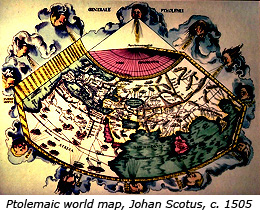|
|
|
 What is a map? By this, I mean to ask what is a “formal map,” of the kind that historians are most likely to study (your kitchen-table imaginary tracing is an informal, ephemeral map). It is almost impossible to arrive at a single authoritative definition of what constitutes a “map.” There are too many varieties of map-like sketches, too many pictures that look like maps and maps that look like pictures, too many ephemeral representations of spatial relations for us to say simply and finally what a map is and isn’t. Geographers and cartographers are continuously embroiled in ongoing debate about this very question. But without doing disservice to this rich discussion, we might distill the conventional wisdom about maps to a few key elements: What is a map? By this, I mean to ask what is a “formal map,” of the kind that historians are most likely to study (your kitchen-table imaginary tracing is an informal, ephemeral map). It is almost impossible to arrive at a single authoritative definition of what constitutes a “map.” There are too many varieties of map-like sketches, too many pictures that look like maps and maps that look like pictures, too many ephemeral representations of spatial relations for us to say simply and finally what a map is and isn’t. Geographers and cartographers are continuously embroiled in ongoing debate about this very question. But without doing disservice to this rich discussion, we might distill the conventional wisdom about maps to a few key elements:
- A map is a representation of space or place, or of phenomena as they exist in space. A map portrays geographical features, spatial features, or a “geography.” A map can be of micro-space (the layout of your bedroom), or of the biggest expanse we know, perhaps a schematic of the cosmos.
- A map represents three-dimensional reality, but usually it is drawn on a flat two-dimensional plane (often a piece of paper). To “translate” effectively between these dimensions, the mapmaker employs various cartographic devices, especially “scale” and “projection.” Most maps have formal elements printed right on the map that give you guidance about how the mapmaker has represented the scene: directional information, keys, and scales are part of most maps. In the next section you’ll learn how to use these devices.
-
A map is much smaller than its subject, sometimes by astonishing degrees of magnitude—for example, a map of the largest country in the world (Russia) might be rendered on a piece of paper as small as an index card. Because of this size differential between real geography and mapped geography, mapmakers must be selective—a map can’t represent all of “reality” in absolute terms, but only some parts of reality. Which parts of “reality” get included on a map varies: first of all, selectivity is determined by the mechanics of drafting and the limitations inherent in drawing big objects on small pieces of paper; but selectivity is also subjective and which parts of “reality” get put on a map depends on the purpose of the map, the mapmaker’s intentions, and the mapmaker’s biases and preferences.
 
|



